
Use of this website constitutes acceptance of the Privacy Policy and User Agreement. Copyright © 2020 Kalimba Magic. All Rights Reserved.
This lesson is for a 17-Note Kalimba in C. To get the most out of this lesson, have such a kalimba in hand.
A Lesson in Improvisation – Dm and F
I put quotes around “improvised” above because there are a lot of elements that were not improvised. I show you how to set up a steady pattern with your left thumb… and then how to improvise with your right thumb. Of course, everything you do on kalimba really requires both thumbs, so sometimes the left thumb has to leave its job as “support” and join in the “improvisation fun”.
There are 16 “Hints” in the video. At those places, I have a bit of wisdom to impart. There are some words in the YouTube video description, but look here for the full hints.
If you don’t want to get very involved, start out by watching what I do in the video and downloading the backing track to jam along with it.
If you want more hints, they are all here!
There will be a lot of freedom in your right thumb’s play, but your left thumb has a job to learn: it will be keeping the beat, it will be defining the harmony changes, and it will be giving the right thumb something to energetically and musically bounce off of. But the left thumb plays an easy part, for the most part. The first 45 seconds of the video deal with building up and understanding the left thumb’s part.
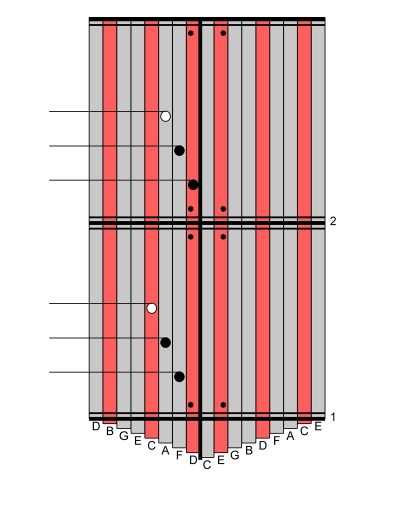
For reference sake, we spell out the F Major chord, which is made up of the notes F, A, and C. As this is the F chord, F = 1. (G would be 2, but it isn’t in the chord.) A is the 3rd of the chord. (Bb would be the 4th, but it isn’t in the chord.) And C is the 5th. The 1-3-5 is called a triad.
The kalimba (and the bass, because they are working together) will stay on the F major chord for 8 beats before changing to the D minor.
The D minor triad is made of D, F, and A. See the tablature above. Notice how two of those notes were in the F Major triad. If D is 1, F is actually the minor 3rd. Don’t worry about that. And A is the 5th of D. Notice how the “1-3-5” of the F triad shifted down a tine to make this “1-3-5” D minor triad. That is a common trick in kalimba music. Learn it and use it.
Again, we stay on the D minor chord for 8 beats before it changes.
Most music I play ends up being “right thumb dominant”. The right thumb often plays the bass notes, or notes that are on the beat. This music is totally left dominant. The Left thumb plays mostly on the beat, and totally exhibits the chord progression. Left lays out the structure of the music… freeing right to be able to dance and play, and improvise against the context of the left thumb. If this approach sounds familiar, it is because that is how a lot of piano music gets made. So, if you are a piano player already, you are probably looking forward to this ride.
By the way, most chord progressions have way more than two chords, but there are also many songs, or parts of songs, that are dominated by just two chords. The Adele song “Send My Love” actually has these two chords, repeating over the whole song, much as this music does. (However, “Send My Love” is in a different key, so you can’t just play along with it on the radio. Sorry.)
The bass also defines the chord progression. It is spending about half the time on an F, during which you should be playing things that center on the F chord. The bass spends about half the time on the D note, which is lower than F. When the bass is playing D, you should be playing things that center on the D minor chord.
But dig this: the bass part gives you a little “blip” of another note right before the chord changes. In other words, if you are improvising and cutting loose, you don’t have to count 8 beats to know when to change. Just listen for that little kick just before the chord change, and flow with that.
Extra points for utilizing the knowledge I have shared with you up to now.
The backing track to the Improv Lesson video.
How did you do, jamming along with the backing track? I imagine you had successes and failures. What comes next in this article will help you improve your abilities in playing along with this track. It will show you my own secrets, and will give you ideas for how to make your own magic happen.
Here, I am only repeating the root note of the chord (the F or the D) on top. However, you have access to all the notes of the triad up there. Those upper notes in the chord, on the right side, will be your prime elements in your improvisations, but all notes are acceptable.
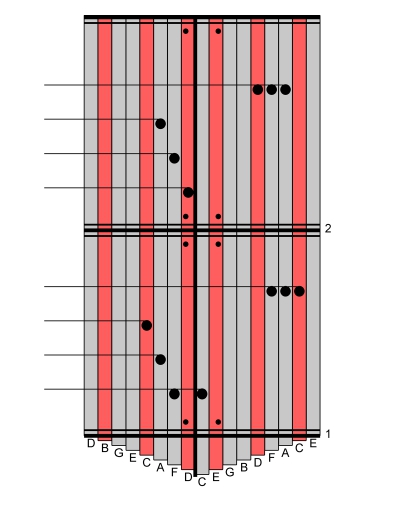
This is a very common figure in kalimba music.
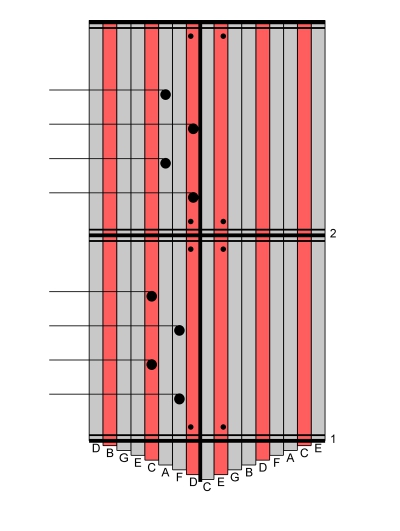
This makes the 1 and 5 of the D minor chord, skipping over the F tine. This is seen in the second half of the tablature above.
The pattern shown in Hint 4 and Hint 5 is the basic left thumb part for the rest of the song. It is highly structured so that the right thumb can improvise against the relatively fixed left thumb. Learn the left thumb part and try any right thumb part with it. For the most part, I am throwing in right thumb strokes on the off beats.
This is not an improvisation, but a prepared bit of music that functions as “home bass”. I spent 45 seconds setting up the left hand part, and now I show you a great example of what you can do with the right hand part. Note that the right thumb part is basically the same as the left thumb goes through its proscribed changes.
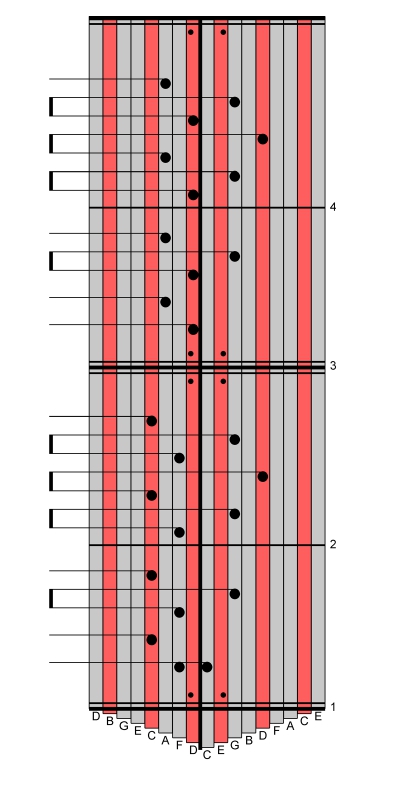
In this music, I play each “thing” twice. This is the repeat pf the “main groove” theme… and halfway through, I cut loose and go somewhere else. In fact, the right thumb is so excited that it drags of the left thumb away from it’s proscribed “1 5” part. The left thumb still does its “1”, but it is also borrowed in conspiracy with the right thumb in creating a melody.
The left is co-opted by right to make a scale-wise melody.
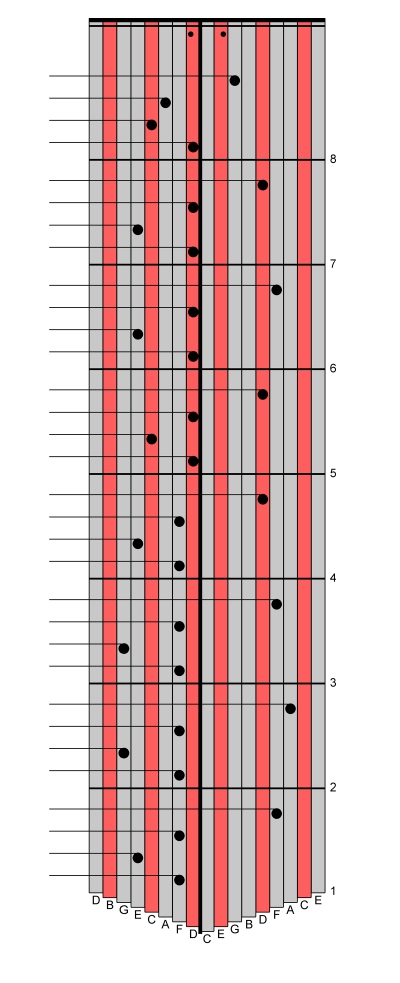
Up until now, the left thumb has always played on the strong beats, with the right thumb playing mostly off beats. For the next few sections, the thumbs’ roles are reversed, and the right thumb plays on the downbeat.
Even though the left thumb is on the off beats, it is mostly playing the same “1 5” pattern as before.
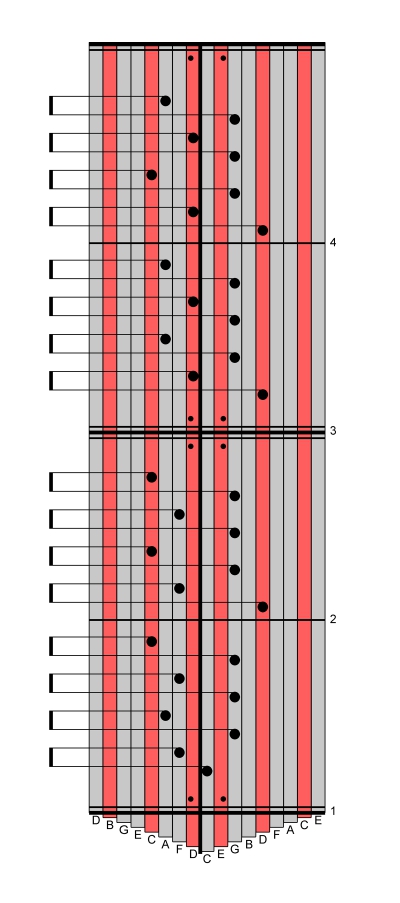
The left thumb is back on the strong beats, and the right thumb is totally off the hook…
OK, your kalimba in tuned to the key of C, meaning all notes are “natural”, and none are “flat” or “sharp”, However, we have been playing in the key of F on this kalimba. The key of F has all naturals, but one flat = “Bb” = “B flat”. That odd note you hear is the B natural when your brain had been lead to believe a Bb would be forthcoming. Up until this point, I have not played any B, so it comes as a shock, so far into the song, to hear the “raised 4th”, ie, a note that is not in the key as you were expecting.
We are back to the “1 5” left hand part that started at Hint 4. Again, you can sneak any right hand note in, especially if it is on an off beat. And just as we did when we first played something like this at Hint 4 and Hint 5, this music leads into the “main groove”.
Remember when i called it “home bass”? It doesn’t matter what it is, as long as you can come back to it and it feels familiar. And remember, you don’t have to copy what I do here – but if you can create your own “main groove” and if you can remember how to play it, and if you can come back to it after flying around on an improvisation, it will be your own “home bass”.
Remember that each phrase is doubled? In part to give you a chance to jump in and copy what I did in the first presentation of the phrase. But in order to keep the music moving, I like to put in variations on the repeat of the phrase. Here, I kind of go crazy with a transition, which will bloom forth into whatever is coming next.
And I am letting myself off the leash to give one last burst of glory. The right thumb is back on the strong beats. And yet, you can still see the outline of the left thumb part that I’ve been playing all along.
Especially when you are doing something like looping, it is good to understand exactly how you are going to end. Just as this backing track spoon feeds you the changes, it drops out a bit just before the end to remind you that it is time to stop playing.
If you are still awake, you might want to just cut loose and see where you go on your own now:
The backing track to the Improv Lesson video.


Sign up for our newsletter and free resources with your email address:
We pinky promise not to spam you and to only send good stuff.
 Assist Paul Tracey Rebuild His House in Pacific Palisades
Assist Paul Tracey Rebuild His House in Pacific Palisades 8-Note Spiral Kalimba Turned into a Student Karimba
8-Note Spiral Kalimba Turned into a Student Karimba Seek to Infuse Your Musical Moments With Beauty and Magic
Seek to Infuse Your Musical Moments With Beauty and MagicUse of this website constitutes acceptance of the Privacy Policy and User Agreement. Copyright © 2020 Kalimba Magic. All Rights Reserved.